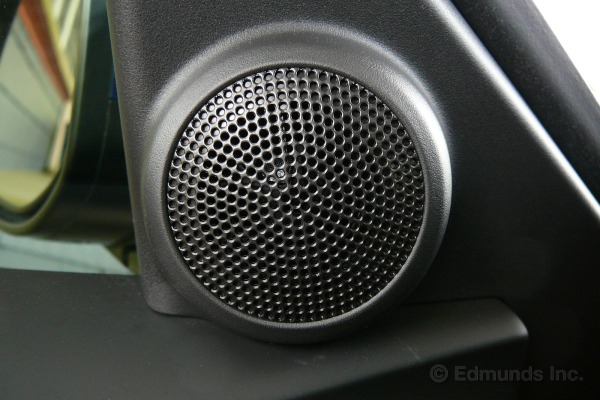
In previous installments of this series we covered the head unit and the amplifier, the components that create and then amplify an audio signal. But without speakers, which take that electrical signal and transform it into sound you can hear, there would be only silence.
What Is Sound?
To understand how a speaker creates sound, it helps to understand that sound is a wave of pressure carried through the air. When such pressure waves reach your eardrum and cause it to vibrate, the brain interprets this as sound. This makes it easy to understand what a speaker does: It vibrates and creates pressure in the air that we hear as sound.
These sound waves or vibrations are measured by how many times they occur per second. The frequency of sound waves is expressed in hertz, also known as cycles per second. The lower the frequency of these vibrations (the less they occur per second, in other words), the lower the pitch of the sound. The higher the frequency of these vibrations (or the more they occur per second), the higher the pitch of the sound will be. You know these opposite ends of pitch by the terms bass and treble.
Human hearing is limited to a certain range of frequencies, usually from 20-20,000 hertz. The deepest bass note we can hear is around 20 hertz, although humans actually feel more than hear such low frequencies. And the highest treble frequencies we can hear are at about 20,000 hertz.
Everyone's hearing is different, of course. Most people experience hearing loss as they age, especially higher frequencies. Short exposure to very loud noises or prolonged exposure to loud noises can equally cause hearing loss. That's why it's a good idea to wear hearing protection at a loud concert or car race and to avoid listening to music at even moderately loud volume in the car or with headphones for long periods of time.
The amplitude or loudness of sound is measured in decibels (dB). With minimal background noise, we can hear very soft sounds well under 50 dB. Things begin to sound what we'd call noisy at about 60-70 dB. Around 80 dB is pretty loud, and prolonged exposure to about 90 db can damage your hearing. Anything louder, such as the 100-plus dB level that some audio systems can produce, can damage hearing very quickly.
What Is a Speaker?
Now that you understand that a speaker creates the pressure that we perceive as sound, let's look at how the speaker itself works. A speaker is also called a transducer, since it converts electrical energy from the amplifier into mechanical energy, which is the movement of a speaker's cone. That cone movement creates the sound pressure we hear.
Audio amplifiers have positive and negative outputs that connect to a speaker's input terminals via speaker wire. Alternating current from the amplifier is then routed through a coil of wire that's called a voice coil, which is connected to the speaker terminals via wire leads. The voice coil is wound around the smaller, tapered end of the speaker's cone. The cone is suspended inside a fixed magnet on the speaker's frame.
The current from the amplifier creates an electromagnetic field around the voice coil. Since the magnet on the speaker's frame is fixed in place and the voice coil can move freely, the alternating current from the amplifier moves the speaker cone to create sound.
Specialized Speakers
The most basic speaker in a car audio system is called "full-range" since it's designed to reproduce the full frequency range of human hearing. But it's physically impossible for a single speaker to accurately cover such a wide range of sounds.
A better approach is to use specialized speakers that are designed to reproduce a specific part of the frequency spectrum. Tweeters reproduce high frequencies, since their small cones can move very quickly. Woofers and subwoofers are large speakers that push much more air, move more slowly and create bass frequencies. Midrange speakers reproduce the frequencies between tweeters and woofers.
More complex audio systems also use midbass drivers to handle frequencies between deep bass and midrange. "Two-way" speakers combine multiple drivers — such as a midrange and a tweeter — on a single frame to save space in a vehicle.
Crossing Over
It takes more power to move the large cone of a subwoofer than the small cone of a tweeter. And the powerful amplified audio signals designed for a subwoofer would damage a small tweeter.
The amplifier article in this series discusses how crossover circuitry divides the audio signal so an amplifier's multiple channels can handle certain frequency ranges. This allows the speakers to get the audio signals they're designed to produce and the amount of power they are designed to handle.
The article mentions that some systems use "passive" crossovers (versus "active" or electronic crossover circuitry in an amplifier) that are in the signal chain after the amplifier. Passive crossovers are found on two-way speakers and divide the frequencies between the two speakers on a single frame.
Wrapping Things Up
The series so far has covered every aspect of a car audio system, from the audio sources in the head unit to sound created by the speakers. The last article will wrap up things by telling you what to look for in a stock audio system and how to improve it if you're not satisfied with the sound it delivers.
You can reference other installments in this series here:
The Basics: Understanding Car Audio Systems, Part 1
The Head Unit: Understanding Car Audio Systems, Part 2
The Amplifier: Understanding Car Audio Systems, Part 3
Features to